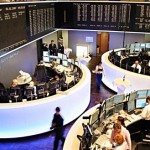West Texas Intermediate erased daily and weekly losses and surged to session highs as the Institute for Supply Management reported that U.S. factory activity grew at the fastest pace in more than two years, exceeding analysts expectations and boosting oils demand prospects.
On the New York Mercantile Exchange, WTI crude for October delivery traded at $107.97 per barrel at 14:26 GMT, up 0.30% on the day. Futures rose to a session high of $108.50 a barrel minutes after the data was released, while days low remained at $106.56. The American benchmark slipped on Monday but erased prior losses and marked a 0.2% advance on weekly basis so far.
Meanwhile on the ICE, Brent crude for delivery in October traded at $115.13 per barrel at 14:29 GMT, up 0.70% on the day. The contract surged to a new days high of $115.68 per barrel minutes after the ISM posted its data, while days low was touched at $114.07 earlier in the session. The European benchmark marked a 0.2% gain on Monday and extended its weekly advance to nearly 1% following Tuesdays surge.
Oil prices were supported recently by upbeat manufacturing data from China and Europe but received a further boost on Tuesday as the Institute for Supply Management reported at 14:00 GMT that U.S. factory activity grew at the fastest pace in 26 months. The institutes ISM Manufacturing index surged to 55.7 in August from 55.4 in July, confounding analysts expectations for a drop to 54.0. This was the highest reading since June 2011.
Meanwhile, a sub-index tracking new orders rose to 63.2 from 58.3 in the preceding month, while employment slipped to 53.3 from 54.4 in July. Values above the neutral level of 50 indicate an expansion in the respective sector.
A separate survey by Markit Economics showed that the U.S. manufacturing sector has expanded at a slower pace than last month. The final Markit U.S. Manufacturing PMI fell to 53.1 in August, underperforming expectations and last months reading of 53.9. The Institute for Supply Managements data for the U.S. however is considered as more influential.
Missiles launched
Markets were rattled earlier in the day as unannounced ballistic “objects” were reported launched from the center of the Mediterranean with an eastward direction. The missiles were picked up by Russia and first reported by a Moscow media. Market players initially sought safe haven security in gold and currencies, as well as made long bets on oil. Tension however eased as the Israeli Defence Ministry announced that it, along with a U.S. team, carried out a test-launch of a Sparrow missile. It was used as a practice for Israels U.S.-backed ballistic shield Arrow as it simulates Irans and Syrias long-range missiles.
Bill O’Grady, chief market strategist at Confluence Investment Management in St. Louis, said for Bloomberg: “The Israeli missile test scared the hell out of a lot of people. There’s been a lot of news, which the market is digesting. Oil is reacting to every headline out there and we should expect to see a lot of volatility going ahead.”
China and Europe
The oil market was well supported recently amid signs of global economic recovery from the U.S. to Europe and China. Last week data showed the U.S. economy grew more than anticipated in the second quarter, which coupled with todays upbeat ISM manufacturing report should give ground for further improvement.
Spain’s manufacturing sector marked an expansion for the first time in two years and surged to 51.1 in August from 49.8 in July, outperforming analysts’s projections for a reading of 50.1. Germany and Switzerland’s indicators remained in the expansion zone but posted a retreat from the preceding month, falling to 51.8 and 54.6 in August from 52.0 and 57.4 in July respectively.
However, Great Britain’s Manufacturing CIPS rallied to 57.2, the highest since 2 1/2 years, surpassing expectations for a surge to 55.0. This was the biggest advance in nineteen years. July’s reading was revised upward to 54.8 from an initial reading of 54.6.
The general Euro zone’s Final Manufacturing PMI surpassed analysts’ expectations for remaining unchanged at 51.3 and rose to 51.4, indicating the the single currency bloc’s economic activity is consistently improving.
On Sunday, the Chinese National Bureau of Statistics reported that the country’s manufacturing Purchasing Managers’ Index surpassed forecasts for a jump to 50.6 according to a Reuters poll and rose to 51.0 in August, the highest since last April, from 50.3 in July.
Earlier on Monday, according to a separate private survey by HSBC and Markit Economics, the HSBC Purchasing Managers’ Index surged to 50.1 in August, marking a major improvement from July’s 11-month low of 47.7 in July and ending a three-month declining cycle. Chinese manufacturers signaled a slight expansion in growth that was based on improving market conditions.
On Tuesday, the government agency reported the country’s services sector grew steadily in August as domestic demand advanced. China’s non-manufacturing PMI slipped slightly to 53.9 from July’s 54.1 and aligned to June’s reading.
Market players will be keeping a close watch on this week’s key U.S. data to gauge the American economy’s strength and oil demand outlook. On Wednesday, the U.S. trade deficit is projected to have widened to $38.6 billion in July from $32.224 billion in June. Thursday’s ADP Employment Change will provide preliminary information for the U.S. labor market and EIAs weekly crude oil inventories report will give an insight into current U.S. demand. Also on Thursday, Q2 Non-Farm Productivity and Unit Labor Costs should have increased, while the ISM Non-Manufacturing Composite and Factory Orders are expected to have declined. On Friday, the U.S. Non-Farm Payrolls should have surged in August, while the Unemployment Rate likely remained unchanged at 7.4%. Average Hourly Earnings and Average Weekly Hours are anticipated to have increased as well.





